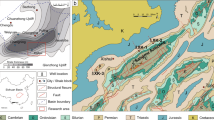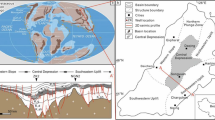Abstract
Due to discrepancies in pore structure, the productivity of shale gas reservoirs under different diagenesis stages varies greatly. This study discussed the controlling of sedimentation and diagenesis on shale pore structure in typical marine, transitional, and continental shales, respectively. Continental shale samples from the Shuinan Formation, Jiaolai Basin, transitional shale samples from the Taiyuan, Shanxi and Xiashihezi Formations, Ordos Basin, and marine shale samples from the Longmaxi Formation, Sichuan Basin, were collected. Scanning electron microscope with argon ion polishing, high-pressure mercury injection, and low-temperature nitrogen adsorption experiments were conducted to acquire pore structure parameters. And the diagenetic stage of the reservoir was classified according to thermal maturity, organic geochemical parameters, and mineral composition. Our results exhibit that continental, transitional, and marine shales are period A, period B of the middle diagenetic stage, and the late diagenetic stage, respectively. For pore structure, micropore (0–2 nm) and mesopore (2–50 nm) controlled pore volume and specific surface area of transitional and marine shales, and specific surface area of continental shale have similar results, while micropore, mesopore, and macropore (>50 nm) all have a significant proportion of pore volume in continental shale. The pore structure characteristics and controlling factors exhibit a pronounced difference in different diagenesis stages, the compaction and cementation in period A of the middle diagenesis stage is relatively weak, intergranular pore and interlayer pore of clay minerals are well preserved, and moldic pore and dissolved pore developed as well; organic matter is in high maturity in period B of the middle diagenesis stage, organic matter pore developed correspondingly, while the intergranular pore developed poorly affected by compaction, notably, the carbonate is negligible in transitional shale, and the interlayer pore of clay minerals are well preserved with weak cementation; while dissolution and metasomatism controlled the pore structure in the late diagenesis stage in marine shale, the primary pores were poorly preserved, and the organic matter pore and carbonate dissolved pore developed. Results from this work are of a specific reference for shale gas development under different diagenesis stages.
Similar content being viewed by others
References
Barth J M (2013). The economic impact of shale gas development on state and local economies: benefits, costs, and uncertainties. New Solut, 23(1): 85–101
Boyer C, Kieschnick J, Suarez-Rivera R, Lewis R E, Waters G (2006). Producing gas from its source. Oilfield Rev, 18(3): 36–49
Burnaman M D, Xia W W, Shelton J (2009). Shale gas play screening and evaluation criteria. China Petrol Explor, 14(3): 51–64
Chen G, Zhang H, Zhou L, Li X, Li X, LI S (2005). Relation between tectonics and the coupling coexistence of multiple energy resources in Ordos Basin. J Northwest U (Natural Science Edition), 35(6):783–786
Chen L, Jiang Z, Liu K, Tan J, Gao F, Wang P (2017). Pore structure characterization for organic-rich Lower Silurian shale in the Upper Yangtze Platform, south China: a possible mechanism for pore development. J Nat Gas Sci Eng, 46: 1–15
Chen Y, Ma D, Xia Y, Guo C, Shao K (2020). Characteristics of the mud shale reservoirs in coal-bearing strata and resources evaluation in the eastern margin of the Ordos Basin, China. Energ Explor Exploit, 38(2), 372–405
Colten-Bradley V A (1987). Role of pressure in smectite dehydration-effects on geopressure and smectite-to-illite transformation. Am Assoc Pet Geol Bull, 71(11): 1414–1427
Curtis M E, Cardott B J, Sondergeld C H, Rai C S (2012). Development of organic porosity in the Woodford Shale with increasing thermal maturity. Int J Coal Geol, 103: 26–31
Elliott W C, Edenfield A M, Wampler J M, Matisoff G, Long P (1999). The kinetics of the smectite to illite transformation in Cretaceous bentonites, Cerro Negro, New Mexico. Clays Clay Miner, 47(3): 286–296
Everett D H, Koopal L K. (2001). International union of pure and applied chemistry. Polymer, 31(8): 1598–1598
Fan A, Yang R, Lenhardt N, Wang M, Han Z, Li J, Li Y, Zhao Z (2019). Cementation and porosity evolution of tight sandstone reservoirs in the Permian Sulige gas field, Ordos Basin (central China). Mar Pet Geol, 103: 276–293
Gao F, Song Y, Li Z, Xiong F, Chen L, Zhang Y, Liang Z, Zhang X, Chen Z, Joachim M (2018). Lithofacies and reservoir characteristics of the Lower Cretaceous continental Shahezi Shale in the Changling Fault Depression of Songliao Basin, NE China. Mar Pet Geol, 98: 401–421
Ge T, Pan J, Wang K, Liu W, Mou P, Wang X (2020). Heterogeneity of pore structure of late Paleozoic transitional facies coal-bearing shale in the southern north China and its main controlling factors. Mar Pet Geol, 122: 104710
Guo C, Dong S, Zhong L (2019). Detrital zircon U-Pb geochronology of Upper Cambrian-Lower Silurian sandstone in the Wushi area, northwestern margin of Tarim Basin: implications for provenance system and tectonic evolution. Acta Geol Sin, 93(11): 2759–2769
He D, Lu R, Huang H, Wang X, Jiang H, Zhang W (2019). Tectonic and geological setting of the earthquake hazards in the Changning shale gas development zone, Sichuan Basin, SW China. Pet Explor Dev, 46(5): 1051–1064
He Z, Nie H, Zhao J, Liu W, Bao F, Zhang W (2017). Types and origin of Nanoscale pores and fractures in Wufeng and Longmaxi shale in Sichuan Basin and its periphery. J Nanosci Nanotechnol, 17(9): 6626–6633
Ji L, Zhang T, Milliken K L, Qu J, Zhang X (2012). Experimental investigation of main controls to methane adsorption in clay-rich rocks. Appl Geochem, 27(12): 2533–2545
Jiang Z, Guo L, Liang C, Wang Y, Liu M (2013). Lithofacies and sedimentary characteristics of the Silurian Longmaxi Shale in the southeastern Sichuan Basin, China. J Palaeogeogr, 2(3): 238–251
Katsube T J, Williamson M A (1994). Effects of diagenesis on shale nano-pore structure and implications for sealing capacity. Clay Miner, 29(4): 451–461
Li Y, Nie H, Long P (2009). Development characteristics of organic-rich shale and strategic selection of shale gas exploration area in China. Nat Gas Industr, 29(12): 115–118 (in Chinese)
Li Y, Wang Z, Pan Z, Niu X, Yu Y, Meng S (2019). Pore structure and its fractal dimensions of transitional shale: a cross section from east margin of the Ordos Basin, China. Fuel, 241: 417–431
Li Y, Yang J, Pan Z, Tong W (2020). Nanoscale pore structure and mechanical property analysis of coal: an insight combining AFM and SEM images. Fuel, 260: 116352
Liang M, Wang Z, Li G, Gao L, Li C, Li H (2017). Evolution of pore structure in gas shale related to structural deformation. Fuel, 197: 310–319
Liu G, Zhai G, Zou C, Cheng L, Guo X, Xia X, Zhou Z (2019). A comparative discussion of the evidence for biogenic silica in Wufeng-Longmaxi siliceous shale reservoir in the Sichuan Basin, China. Mar Petrol Geol, 109: 70–87
Liu Z, Wang H, Man X (2015). Application of geological theory in shale gas exploration and development. Adv Mat Res, 1092–1093: 1346–1350
Long S, Peng Y, Liu H, Zhao C, Zhao J, Yu L, Sun C, Tang X (2017). Micro-Characteristics of the shale in the first member of Silurian Longmaxi Formation in southeastern Sichuan Basin, China. J Nanosci Nanotechnol, 17(9): 6662–6669
Loucks R G, Reed R M, Ruppel S C, Jarvie D M (2009). Morphology, genesis, and distribution of nanometer-scale pores in Siliceous mudstones of the Mississippian Barnett Shale. J Sediment Res, 79(12): 848–861
Pan J, Peng C, Wan X, Zheng D, Lv R, Wang K (2017). Pore structure characteristics of coal-bearing organic shale in Yuzhou Coalfield, China using low pressure N2 adsorption and FESEM methods. J Petrol Sci Eng, 153: 234–243
Peng Y, Long S, He X, Tang J, Nie H, Gao Y, Xue G, Fan Y, Liu Y (2020). Characteristics of normal-pressure shale gas reservoirs and evaluation of its favorable areas in Penshui. Petrol Reserv Evaluat Developt, 10(05): 12–19
Qiu L (2018). Research on shale reservoir characteristics of Shuinan Formation in northern Jiaolai Basin. Dissertation for Doctoral Degree. Xuzhou: China University of Mining and Technology (in Chinese)
Song W, Yao J, Li Y, Sun H, Zhang L, Yang Y, Zhao J, Sui H (2016). Apparent gas permeability in an organic-rich shale reservoir. Fuel, 181: 973–984
Tian T, Wang H, Zheng R, Hou C, Wang C (2014). Low permeability reservoir characteristics of Chang 8 oil reservoir set in Zhenyuan area, Ordos Basin. Lithol Reserv, 26(1): 29–35 (in Chinese)
Wang M, Xie W, Huang K, Dai X (2019). Fine characterization of lithofacies and pore network structure of continental shale: case study of the Shuinan Formation in the north Jiaolai Basin, China. J Petrol Sci Eng, 175: 948–960
Xie W, Wang M, Wang X, Wang Y, Hu C (2021). Nano-pore structure and fractal characteristics of shale gas reservoirs: a case study of Longmaxi Formation in southeastern Chongqing, China. J Nanosci Nanotechn, 21: 343–353
Xiong F, Jiang Z, Chen J, Wang X, Huang Z, Liu G, Chen F, Li Y, Chen L, Zhang L (2016). The role of the residual bitumen in the gas storage capacity of mature lacustrine shale: a case study of the Triassic Yanchang shale, Ordos Basin, China. Mar Pet Geol, 69: 205–215
Xiong F, Jiang Z, Tang X, Li Z, Bi H, Li W, Yang P (2015). Characteristics and origin of the heterogeneity of the Lower Silurian Longmaxi marine shale in southeastern Chongqing, SW China. J Nat Gas Sci & Eng, 27(P3): 1389–1399
Yang W, Song Y, Jiang Z, Luo Q, Wang Q, Yuan Y, Zhang C, Chen L (2018). Whole-aperture characteristics and controlling factors of pore structure in the Chang 7 continental shale of the Upper Triassic Yanchang Formation in the southeastern Ordos Basin, China. Interpretation (Tulsa), 6(1): T175–T190
Zhang J, Li X, Xie Z, Li J, Zhang X, Sun K, Wang F (2018). Characterization of microscopic pore types and structures in marine shale: examples from the Upper Permian Dalong Formation, Northern Sichuan Basin, South China. J Nat Gas Sci Eng, 59: 326–342
Zhao C, Zhu X (2001). Sedimentary Petrology. 3rd ed. Beijing: Petroleum industry press
Zhao J, Jin Z, Jin Z, Geng Y, Wen X, Yan C (2016). Applying sedimentary geochemical proxies for paleoenvironment interpretation of organic-rich shale deposition in the Sichuan Basin, China. Int J Coal Geol, 163: 52–71
Zhao J, Jin Z, Jin Z, Geng Y, Wen X, Yan C (2017). Nano-scale pore characteristics of organic-rich Wufeng and Longmaxi Shales in the Sichuan Basin, China. J Nanosci Nanotechnol, 17(9): 6721–6731
Zhu X (2008). Sedimentary Petrology. Beijing: Petroleum Industry Press
Acknowledgements
This work is supported by the Major Project Cultivation of CUMT (No. 2020ZDPYMS09), the Foundation Research Project of National Science and Technology Major Project (No. 2017ZX05035004-002), and the Fundamental Research Funds for National Universities, China University of Geosciences (Wuhan).
Author information
Authors and Affiliations
Corresponding author
Rights and permissions
About this article
Cite this article
Xie, W., Wang, M., Wang, H. et al. Diagenesis of shale and its control on pore structure, a case study from typical marine, transitional and continental shales. Front. Earth Sci. 15, 378–394 (2021). https://doi.org/10.1007/s11707-021-0922-9
Received:
Accepted:
Published:
Issue Date:
DOI: https://doi.org/10.1007/s11707-021-0922-9




